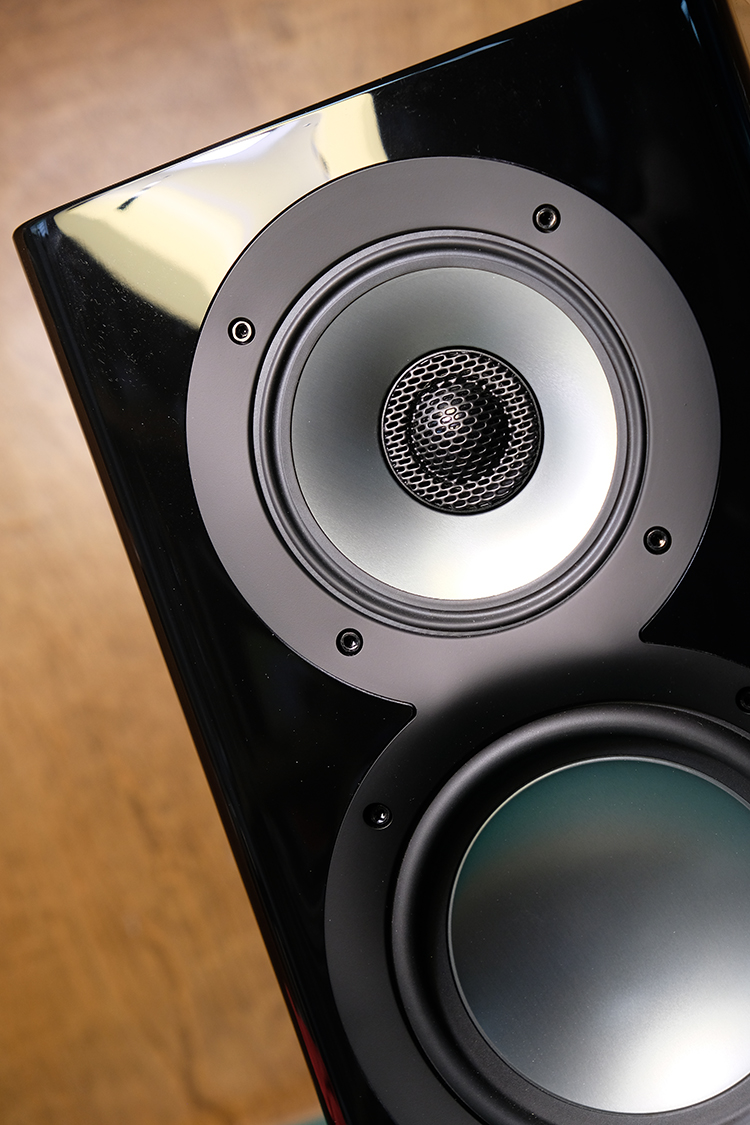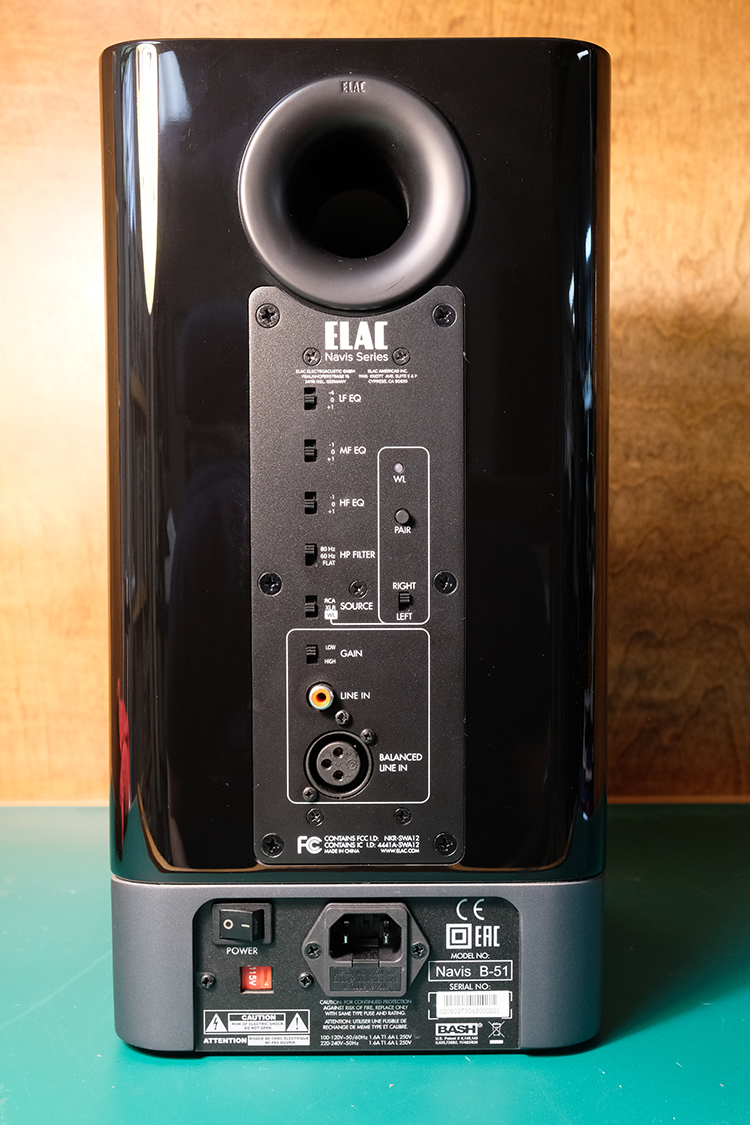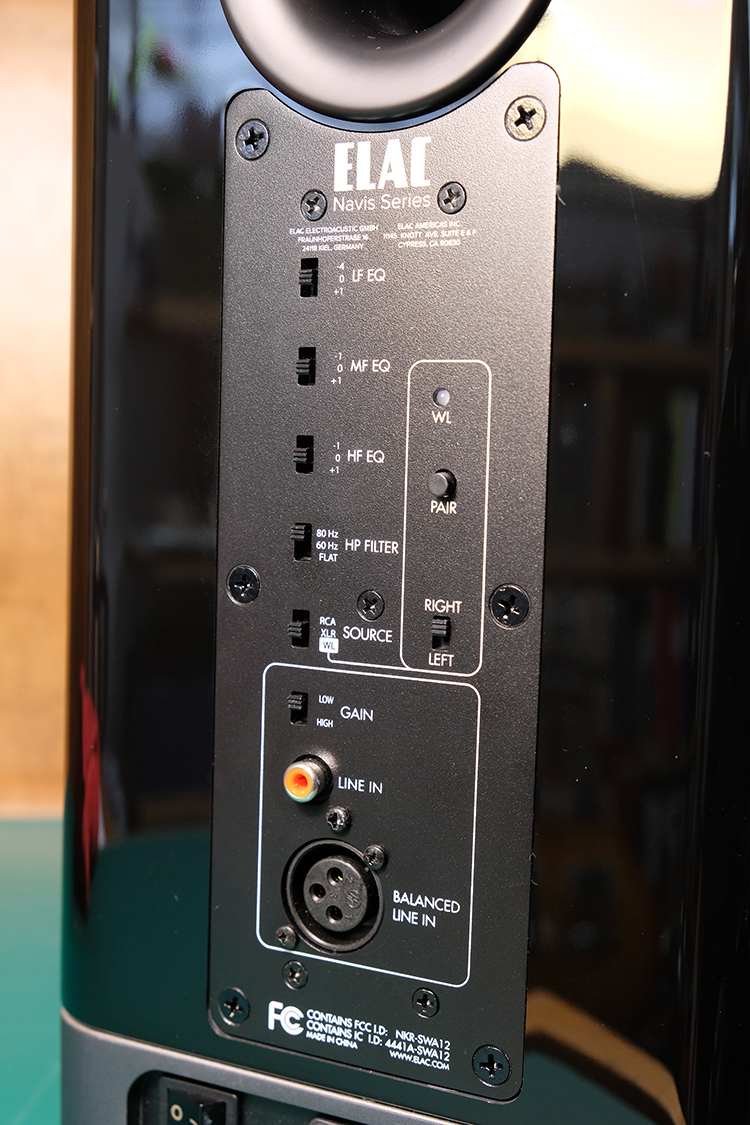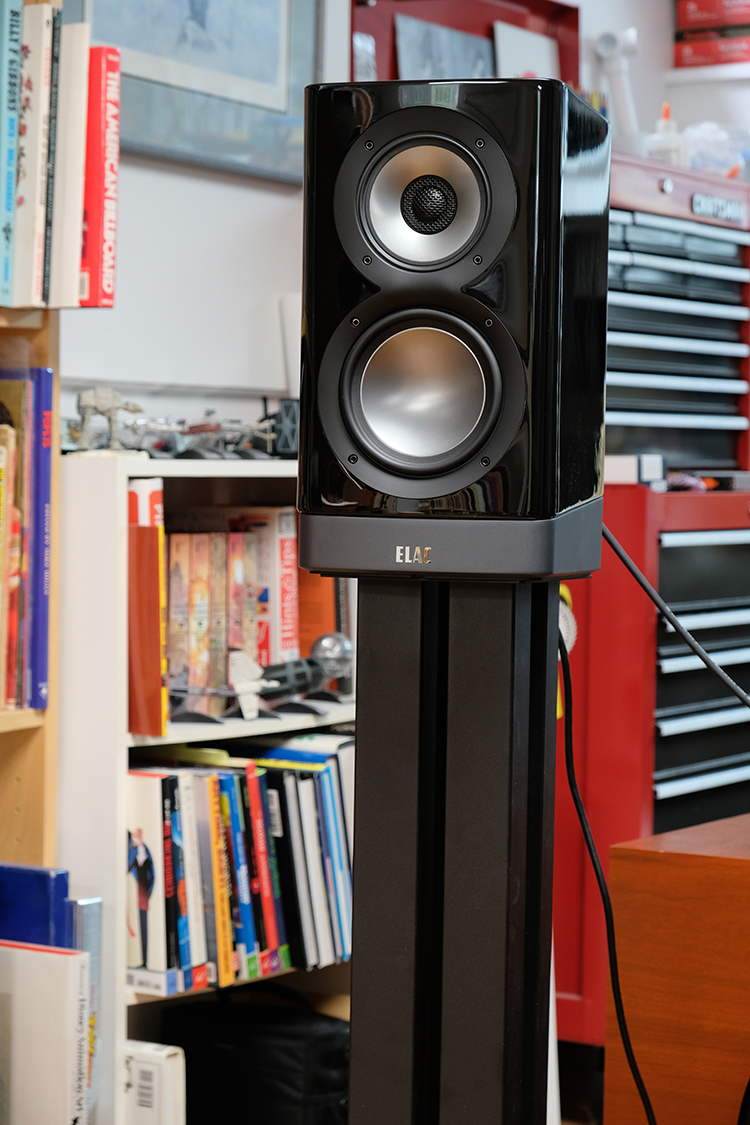Active loudspeakers, once fit only for specialized use in recording studios or relegated to an afterthought addition to your desktop computer, are seeing growing acceptance in serious home Hi-Fi setups. ELAC’s Navis line has both a floor-standing model and the bookshelf pair that is the subject of this review.
ELAC Navis ARB-51 Active Bookshelf Speaker
- Fairly detailed and “alive” sound quality.
- Uses a concentric tweeter/midrange driver combination.
- Built-In amplifiers with analog crossovers.
- Surprising bass response in a large room.
- Just plug these into a source with a volume control and you’re off.
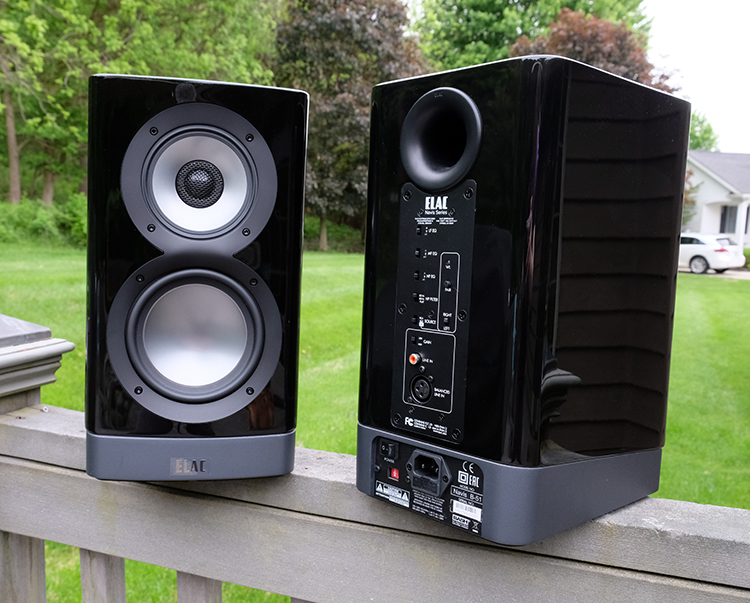
The ELAC Navis active speaker line has been around for at least a year now and both the floor-standers and the bookshelf models have received uniform accolades from many reviewers out there in the hither and yon. Truth be told. I’ve had these speakers for a little while, longer than I probably should have in fact. But the problem was, I kept finding all sorts of different uses for them. In my regular studio space, upstairs in the living room, as main channels in my home theater, etc. And, subjectively, they sounded good enough that I kept comparing them to other speakers that I had coming in and out of my house. And ELAC’s choice to eschew having an integrated A/D and D/A section, or any sort of DSP, in an active speaker, was an interesting (read old-school) sort of approach compared to competitors such as KEF’s LS50. Does this approach make sense in this day and age? I ultimately kept asking myself if all the hoopla about these speakers was well deserved. Read on and let’s see.
Description:
3-way Bass Reflex Active Bookshelf Loudspeaker with rear-firing port
High-Frequency Driver:
Single 1″ Soft Dome, Concentrically Mounted
Mid-Frequency Driver:
Single 4″ Aluminum cone driver
Low-Frequency Driver:
Single 5-1/4″ Aluminum cone driver
Frequency Response:
44 Hz – 28 kHz (Manufacturer)
Crossover Frequencies:
260 Hz, 2.2 kHz
Total Amplifier Power:
300 Watts Total
Bass Amplifier:
160-Watt Bash Amplifier
Midrange Amplifier:
100-Watt Bash Amplifier
Tweeter Amplifier:
40-Watt Class AB Amplifier
Inputs:
RCA / XLR / AirX² Wireless
Cabinet finishes:
Gloss Black, Gloss White, Gloss Ebony Emara
Dimensions (H x W x D):
13.58″ x 7.44″ x 9.45″
Net weight:
17.85 lbs. (each)
MSRP:
$2,299.98 (pair)
MANUFACTURER’S WEBSITE:
Company:
SECRETS Tags:
2020 Speaker Review, elac, navis, speakers, active, concentric
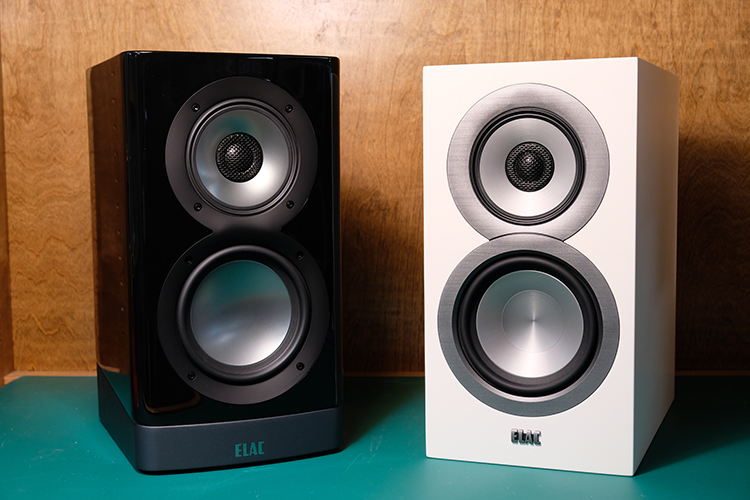

The compact 3-way ELAC Navis bookshelf speaker looks very much like the company’s Uni-Fi Slim bookshelf speakers, which I previously reviewed, albeit with softer rounded edges and a nice glossy paint finish. But those cursory surface details are where the similarity ends. While it may have been Chief Designer Andrew Jones’ initial start-off point (make an active version of the Uni-Fi speakers), the Navis is a complete top-to-bottom redesign. While the driver compliment may look the same as the Uni-Fi, the drivers themselves, specifically the coaxial tweeter and midrange units, are said to have been redesigned to achieve better integration as they hand off to one another. As this is an active speaker, all the associated electronics are located inside the grey base of the unit and each speaker needs to be plugged into a power outlet. No speaker cable required. Once a music signal enters the Navis, it is divided up 3 ways by an analog electronic crossover, and each portion is sent to a dedicated amplifier (there are 3 in the Navis) and then on to the appropriate driver. The benefits of active speakers have been known for years. Each driver can have its own amplifier whose performance is tailored to get the best results from the respective driver’s operating range and, with that in mind, the crossovers can be further optimized to improve overall performance as well. And having the crossover appear before the amplifier stage also reduces the inherent signal losses that would happen in a traditional passive speaker design.
Second, it allows an owner to continue using the electronic equipment (read DACs, preamps, etc) of their choice and not be limited by what ADC and DAC chips are in the active speaker. And third, the benefits of designing the right synergy between the crossover, amplifiers, and drivers are big enough to warrant the active approach.
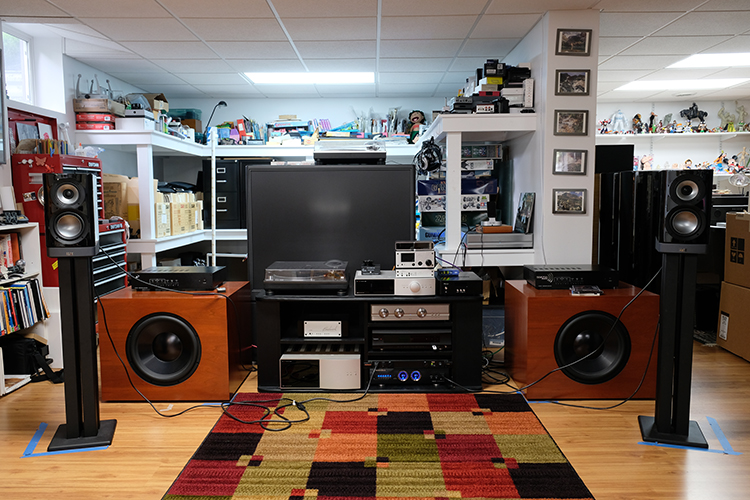
I set up the ELAC Navis ARB-51 in my studio listening area positioned about 9-feet apart on Monoprice Monolith 32-inch stands and toed-in at about a 10-degree angle, as this is how I customarily start. My seating position was also just under 10-feet away from either speaker. After some experimentation, I brought them a little closer together, settling in at just over 8-feet apart, and toed them in further so that the tweeter line-of-sight converged just behind my head for the remainder of the review. After trying out the tweeter, midrange, and bass trim switches to hear their effects, I elected to leave all the switches in the default positions as that is what ultimately sounded best to me. An OPPO BDP-105D Universal Player served as a main audio source along with an ELAC Discovery Music server using ROON to manage my music files. Control components alternated between a NAD C658 streaming DAC, my Bryston BP-25 preamplifier, and a Benchmark Media systems HPA4 preamp and DAC 3B DAC. For a vinyl source, I used my Technics SL1200 Mk 6 modified by KAB Electroacoustic, along with an Audio Technica OC9ML/II Moving Coil phono cartridge. This was hooked up to the Pass Labs XP-25 Phono preamp. Speaker and interconnect cables were from Blue Jeans Cables. The speakers also ended up finding their way into our home theater as the front left and right channels and our upstairs living room hooked up in stereo to an old Denon receiver with preamp outputs.
The other quality that stands out immediately with the Navis is the precision of the imaging. Placement of vocals and instruments in the acoustic space generated by these speakers is quite pinpoint, very much what you would expect from a high-quality active monitor. As I mentioned before, these are the sorts of dividends that are paid when drivers, crossover design, and amplification are optimized to work as a cohesive whole from the get-go. While the Navis ARB-51 may not be quite as ultimately revealing as the best active monitors out there, those tend to have DSP included and are comparatively much more expensive and specialized.
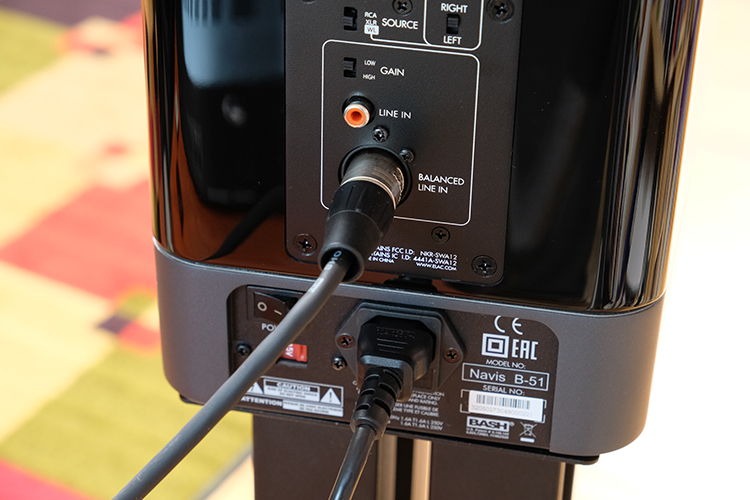
Beyond the bass and the imaging, Andrew Jones’ ELAC designs have always done an admirable job of getting the midrange to sound very sweet and agreeable to my ears, and the Navis are no exception. Whether I was listening to Sinatra, Bennett, or Waits (and perhaps a side or two of Pavarotti) or Fitzgerald, Krall and Simone, male and female vocals of every stripe always sounded clear, precise and natural. Nothing sounded overly forward, they were always just where I expected they should be. The blending between the midrange and tweeter elements of the concentric driver was quite seamless. The refinement of the design of that concentric driver along with the active implementation, I’m sure, account for the imaging accuracy that the Navis possess. It is definitely a step up in sound from the Uni-Fi bookshelf speakers that I’ve reviewed previously. Since I still had the pretty white Uni-Fi Slim bookshelf speakers here, I was able to do some quick comparisons between the two. And while both the Uni-Fi and the Navis share a familial bond with their driver and design DNA, it was patently clear that the Navis was a superior speaker in overall transparency, resolution, and imaging. The Uni-Fi is still a great little speaker for the money. Hook them up to some good electronics and a healthy dose of amplification and they will just boogie all day long and you won’t get tired listening to them. The Navis is like the Uni-Fi but turned up to 11! Everything that I was hearing on the Uni-Fi was played back with more clarity and specificity on the Navis. Where I thought I knew where instruments and details were when listening on the Uni-Fi, I knew exactly where they were when listening through the Navis. The bass on the Navis also felt like it had a little bit more wallop than from the Uni-Fi but I don’t think it actually reached any lower in range.
So while it became plain to me that the Navis ARB-51 was certainly a step up in sound from the Uni-Fi, at $2300.00 for a pair, it does beg the question of how the Navis would compare against a similarly priced passive speaker with related types of drivers. The KEF Reference 3 specifically comes to mind. Where the Navis may have an edge in being active, the KEF Reference 3 has a larger woofer and more refined and advanced concentric drivers. It’s a tempting thought that I may have to investigate this further in the coming months. I know I liked listening to the Navis a little more than the JBL 4312G that I had here months ago, but that’s more of an apples and oranges sort of comparison as those JBLs were voiced for a specific sound/market segment. I would also be curious to compare the Navis to the new ELAC Debut Reference. I got the distinct impression from Andrew Jones at the speaker’s launch that enough performance refinements had been made to the Debut Reference to perhaps uncomfortably encroach on the more expensive Uni-Fi. But that’s for another time.
In my studio space having the Navis ARB-51 hooked up to the Benchmark HPA4 Preamp and DAC3B made for a nice, compact, and scrupulously clean sounding setup. Music sounded wonderfully natural and dynamic both in the sweet spot and when listening casually off-axis. And while I didn’t mess with the frequency trim switches much after initial setup, I did experiment some with the crossover roll-off settings. I wanted to see how successful I could be at integrating my twin DIY 15-inch Dayton Reference subwoofers with the Navis using just the analog controls on the speakers and the subwoofer amplifiers along with REW for some measurements. I could have made this easier on myself by using the Anthem STR preamplifier with its ARC room correction and integrated bass management, but I’m nothing if not mildly inquisitive and excessively stubborn when an idea pops into my head. Besides, I wanted to play a little and sometimes room correction can sound a bit sterile to me.
I elected to use the summed mono balanced output from the Benchmark preamp (split via a y-cable) to each of the two subwoofer amplifier inputs. After copious measurements with REW and subsequent tweaking of each subwoofers level, phase, and Low-Pass filter settings, I was able to get, what I considered, a fairly successful blend between my subs (set to approximately 80 Hz Low-Pass) and the Navis speakers set at an 80 Hz High-Pass filter setting. Now I know there is much opinion online on the subject of stereo bass versus mono bass when dealing with a 2.2 channel system. I think the ultimate answer depends a lot on your room and how your speakers and subs best integrate with it. In my room having stereo bass demands much higher gain on both of my subwoofer amplifiers and the left channel sub to speaker integration has a moderate null just below the crossover frequency. The right channel integration was better, and in mono that helps offset the deficiency in the left channel response. With everything said and done I felt I ended up with a nice overall balance, having both the dynamic and transparent virtues of the Navis, nicely melded with the impact of the additional 2 bottom octaves of bass. That and a nice natural bump in the response at 28 Hz provided by the room made for a really enjoyable experience. Again, it’s not “textbook” and using room correction properly will get you a better result melding sats and subs, but what can I say? I liked what I was hearing!
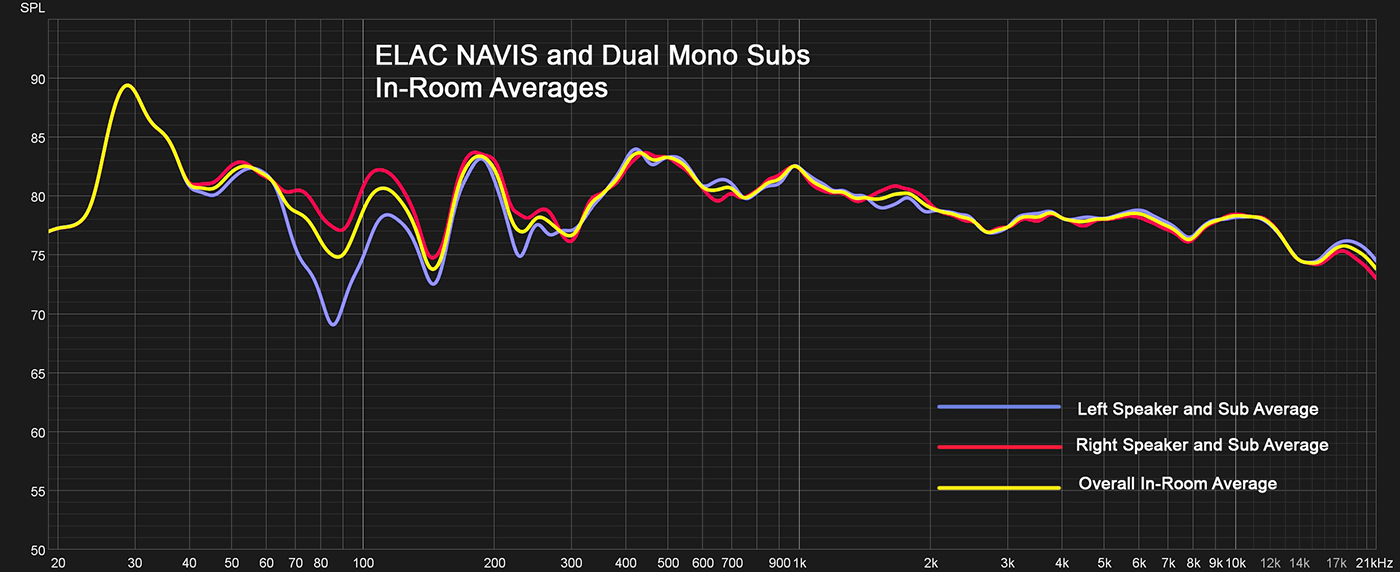
The little Navis bookshelves also turned out to be a very flexible speaker in that they fit a variety of different situations that we had around here. We tried them out in our small upstairs living room, in a two-channel setup driven from the pre-outs of an old Denon receiver, with excellent results. During my wife’s time working from home due to Ohio’s COVID-19 restrictions, we set up a small office space in our loft and she wanted to have a simple music system there. I set up the Navis on the shelf top of a half wall, hooked up to the NAD C658 streaming DAC. With that minimalist setup, she was able to stream from several different sources via the BluOs app on her iPhone. She seemed very pleased. I also used the NAVIS ARB-51 for the main channels in our home theater along with an ELAC Uni-Fi Slim center channel speaker and ELAC Debut on-wall surrounds to create a fairly harmonious system. Using my Anthem MRX-1120 as the control center, the system gelled together very well in our medium-sized room. Well enough in fact that I would consider a surround system having at least the front 3 channels made up of these speakers, if not all 5 channels if possible, to be a superb choice as a home theater solution in a medium-sized room. Imagine 5 active matched speakers in a surround configuration, with appropriate subwoofer support, that does not dominate a room. That would be ideal particularly if you are a multi-channel music fan.

Various Artists, “The DALI CD Vol. 5, DALI Music, 24/96 FLAC Download, 2018″
This is the fifth in a series of well-recorded samplers from speaker maker DALI of Denmark. They have had their own music label for a little while now and have been making a point of recording and showcasing the local and quite diverse Danish talent at their disposal. The very soulful track “Sugar Man” by Erann DD is great fodder for the little Navis speakers to just nicely peg the singer’s gritty vocals. Resonant and full of detail, his voice was imaged precisely in center space just ahead of the speakers.
The strumming acoustic guitar also had a lovely tone with plenty of string detail and a solid-sounding kick drum periodically punctuated the tune with impact. “Il Core Vi Dono” by the duo known as Operazione is an operatic piece with a tenor and a soprano both singing together and performing solo. The Navis ARB-51 cleanly and clearly rendered their vocals, tenor at center-left and soprano at center-right, with the tenor’s voice having the right tonality and just enough weight to be proper. The soprano’s voice rings as clear as a bell and even at the highest part of her range, the ELACs avoid becoming shrill. When both voices duet together, the contrast between the two, backed with the strings, is just so tantalizing to listen to. “Eight Bars on the Way Home” is by the modern jazz trio GinmanBlachman and consists of bass, drums, and piano. A sultry and intimate sounding instrumental, the Navis go right to work throwing out a wide soundstage. It nicely frames the thick and deep sounding acoustic bass notes, the glistening drum cymbals, and the lovely ring and decay of the grand piano notes. The aggressive plucks during the bass solo had a great intensity and plenty of string detail to them too.
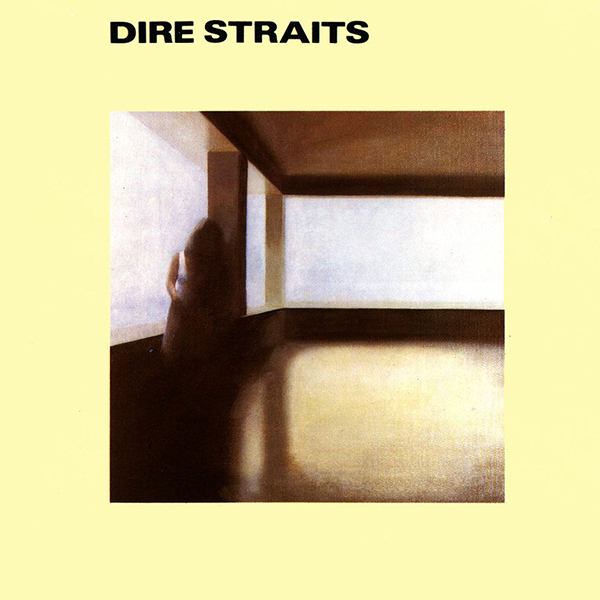
Dire Straits, “Dire Straits, Warner Bros Records, CD, 1978″
A chestnut that gets a lot of play around here when I just want to listen to honest skillfully played rock and roll. “Water of Love” has just some fantastic steel guitar playing by Mark Knopfler that sounds so resonant and zingy via the concentric tweeter and midrange drivers. I can easily pick out the details of each string as he plays through the Navis. Again, the soundstage is nice and wide on this track and clear details like hands hitting the drum skins provide a nice tonal contrast to just standard sticks on a kit.
“Six Blade Knife” is another favorite with it’s deep, moody bassline that sounds nice and punchy through the ELACs. Mark Knopfler’s voice carries an especially ragged edge through some of the verses that the Navis fully reveal and exploit right in the dead center of the image. And, of course, there is that spare but perfectly judged guitar playing with the unmistakable Stratocaster ring that sounds so right through these speakers.
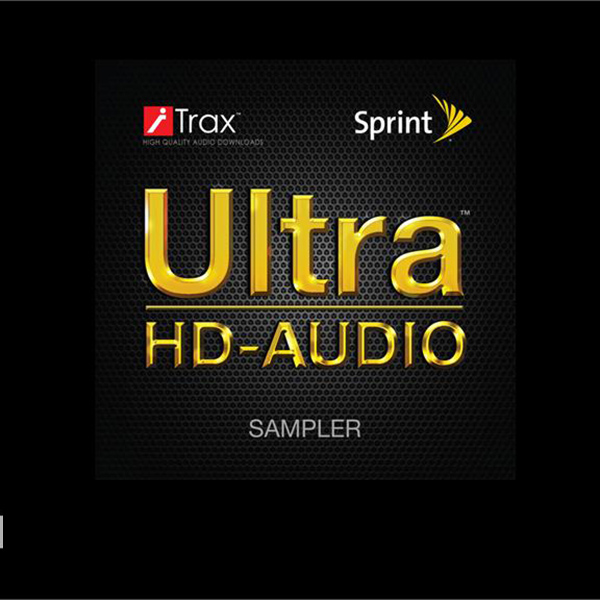
Various Artists, “i-Trax/Sprint HD-Sampler, AIX Records, 24/96 FLAC Download, 2020″
Mark Waldrep’s AIX records has an enviable reputation for producing quality high-resolution recordings in both multi-channel and stereo. He recently made this sampler of some of his favorite selections (18 tracks) available in stereo for free download here. It’s not just a great variety of selections to test speakers with but it’s also wonderful high-fidelity music to just sit back and enjoy. “Primavera” by The Banda Brothers features a smooth and powerful female vocal that sounds dynamic, transparent, and distortion-free through the ELACs even when pushed at high volume.
Her vocal range is impressive, and the speakers reproduce it without issue. The flute playing in this track sounds exquisite with fantastic detail and spatial cues during the solo and accompaniment. “Let Them In” by John Gorka has the Navis rendering his intimate vocals with proper depth and weight to the sound without getting tubby or muddy. Gorka’s piano playing sounds expansive, with a spotlessly clear ring and decay to the notes. The background mandolin playing is crisp and melodic with the resonance of the instrument’s wood body being clearly heard. The included “Allegro” movement from The Brandenburg Concerto No. 3 is an especially vivid and dynamic recording. The little ELACs really bring this track to life with excellent detail and separation on the individual stringed instruments. As before, the speakers image precisely and splay the soundstage widely to give me a good physical sense of the orchestra’s size. The harpsichord is especially notable as it is clearly rendered and not overwhelmed by everything else as can happen in other versions of Brandenburg that I’ve heard.
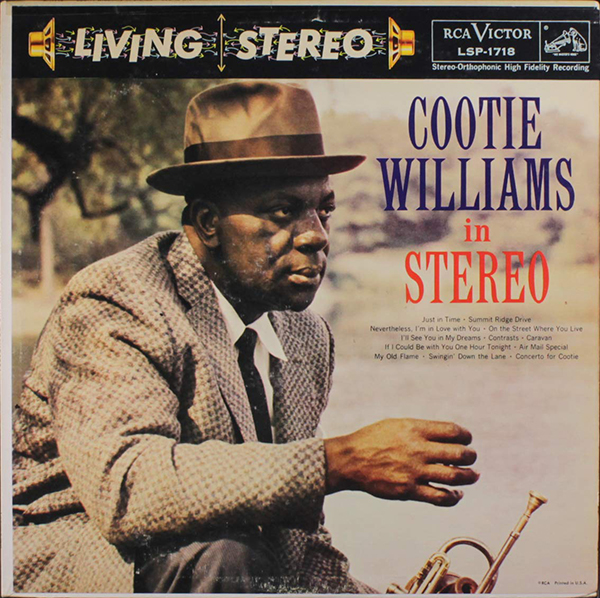
Cootie Williams, “Cootie Williams in Stereo, RCA, 1958, LSP-1718, LP”
A very well recorded jazz/big band album, particularly for the time. The Navis bookshelves do a lovely job of spreading the band out wide in front of me along with accentuating the great depth of image available with this recording. On “Caravan” the speakers clearly reproduce Williams playing his muted trumpet dead center of the soundstage, and they also catch all the finer details of the trumpet’s sound as he is manipulating the plunger mute. It almost feels like he is in my listening room, it sounds that good.
But beyond just Cootie’s excellent trumpet work, the rest of the band is presented as if it is completely encircled behind him, adding to that sense of depth and dimension. On this recording, I am also able to notice a clearer distinction between the different trombones and saxophones more than some other big band style recordings that I have. Kudos go to both the recording engineer and to the ELACs on that. A big band horn section can sound positively shrill and brutal on the wrong speakers, but there is not a hint of harshness at all listening through the little ELACs, even when the volume was turned up. Everything sounded properly brassy but smooth enough that I could listen to this album all day. Another stand out track is “Air Mail Special” for the nice-sounding and tasteful background piano solo and tight, punchy bassline.
Measurements by Carlo Lo Raso with technical analysis by Carlo Lo Raso and David A. Rich.
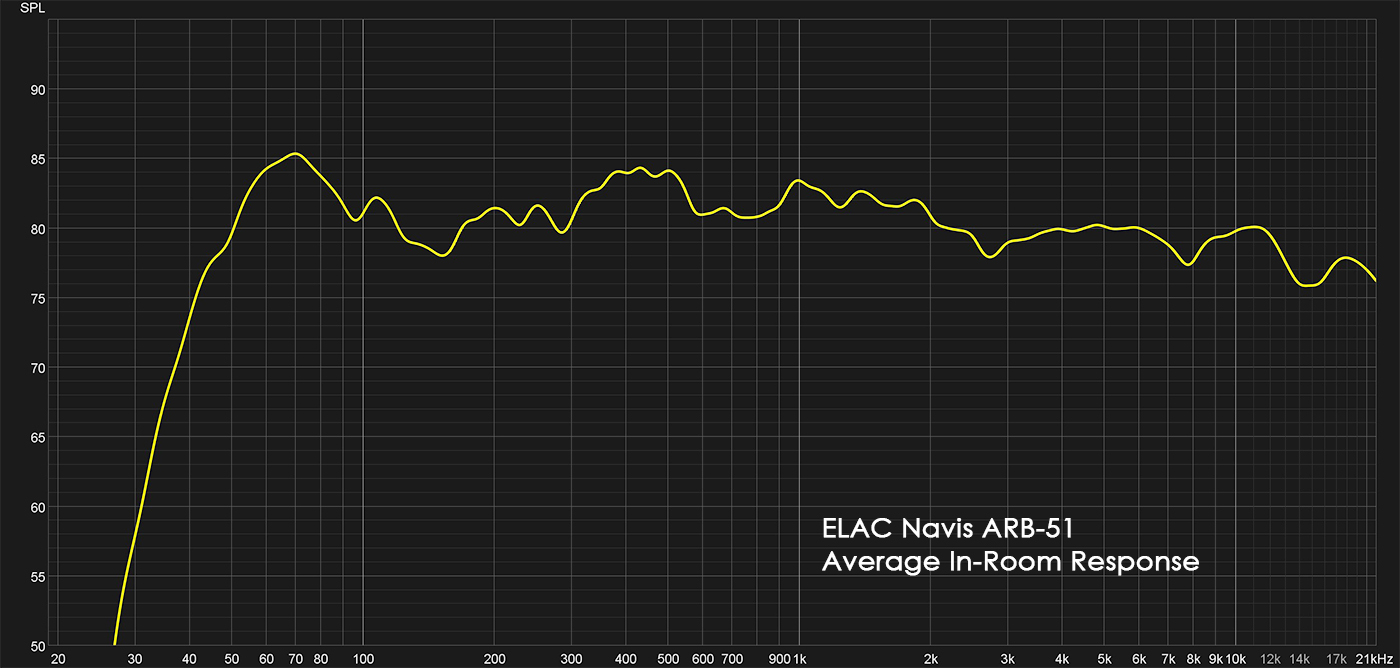
This in-room measurement is an 18-point spatial average. A 9-point measurement was made for the right speaker and then repeated for the left speaker. Averaging both speakers is an approach others have been using and publishing. Using data from both speakers reduces the modal response of the room by averaging the differences in the response of the two speakers from room asymmetries. The technique cannot eliminate them however and, as such, the response below 300Hz remains room dominated. The results show a fairly consistent response from 200 Hz on up, exhibiting dips at 2.8 kHz and 8 kHz and between 12 – 17 kHz. We will see these ripples in the quasi-anechoic listening window below. They are not room issues.
The 500Hz – 900Hz response dip is again room related. For the Navis, nothing in the quasi-anechoic response predicts this although other small bookshelf speakers in this price range have not shown this dip in the in-room response curves
In other three-way passive speakers in this price range this dip would be a result of the 600Hz – 800Hz crossover point. This is a money-saving move if the midrange is 5.25 inches or more. To crossover lower, you need larger inductors and capacitors which cost more. These days it is the 2.5-way floor stander which saves even more money on the crossover and has worse issues around the crossover point. Unfortunately, the coax driver in the ELAC is not 5.25 inches but 4 inches. A driver that small cannot normally be crossed over at 260Hz without a huge distortion penalty.
Since this is an active speaker it is easy to put the crossover at a low value since the parts are ahead of the power amp. The reactive components see low voltages and small currents. One would think the passive version of this ELAC Uni-Fi BS U5 would have a higher crossover frequency given the cost of the parts but it turns out not to be true looking at a photo of the crossover I found on the web. Looking at the parts, it is a high order crossover between the woofer and midrange elements at 260Hz. ELAC puts a lot of money in that passive crossover for the speaker’s price. The passive version has the issue with THD at 250Hz as was shown in the Secrets review. The dip at 160 Hz seems to be an artifact of the room as it is showing up regularly in my measurements. Bass response is solid down to about 50 Hz before rolling off. Treble response seems to remain consistent past the 2.2 kHz crossover point (albeit at a slightly lower level than the midrange) and gradually tapers off beyond 12 kHz.
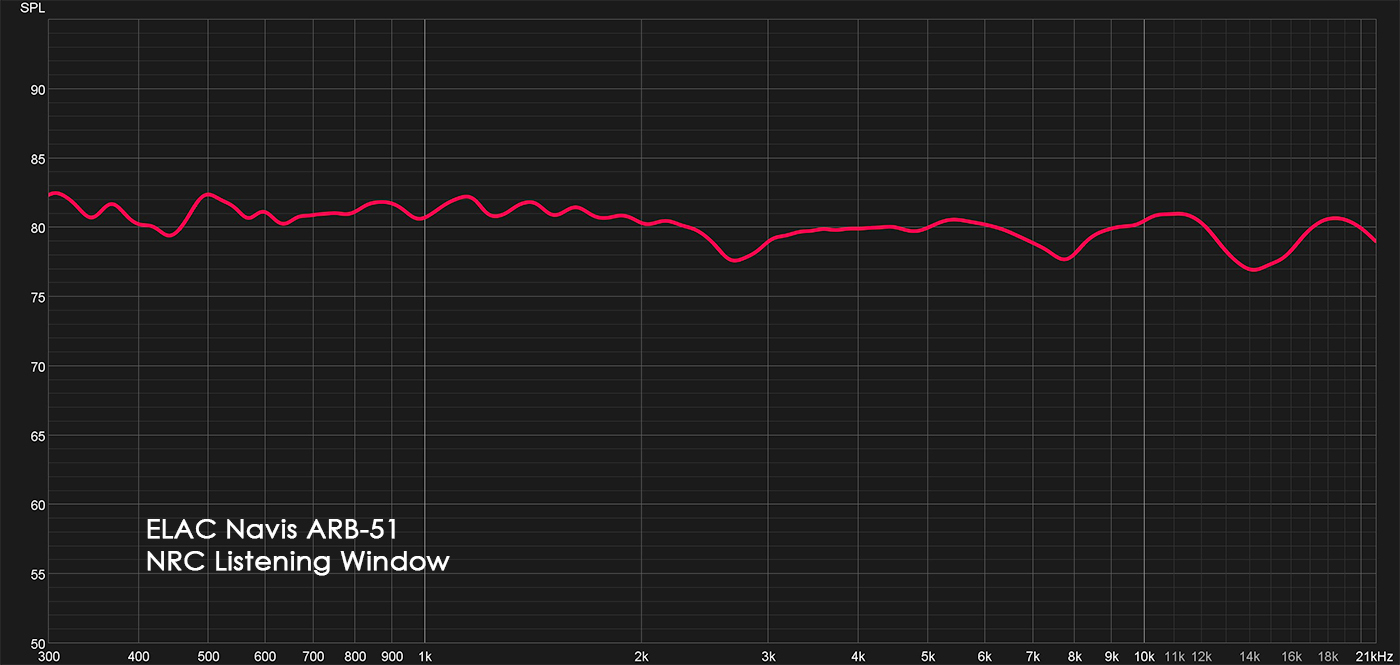
This is a plot of the NRC listening window scaled from 300 Hz on up which is averaged from the following measurements: 0-degree on-axis, +-15 vertical, +-15 horizontal, and +-30 horizontal. At 2.8kHz we see a dip that may be associated with the crossover although this is a surprise given the active crossover design which can produce much more accurate crossover slopes given more available reactive elements, and the coax driver.
The tweeter is at a lower level that the midrange correlating with the in-room measurement. At 7kHz the dip is interference between the tweeter and coax midrange cone. The dip at 15kHz may also be related to the coax. A resonance is also a possibility. The fact that the dip is in the in-room plots points to a possible resonance. In any case, we have seen flatter tweeters in bookshelf speakers in this price range.
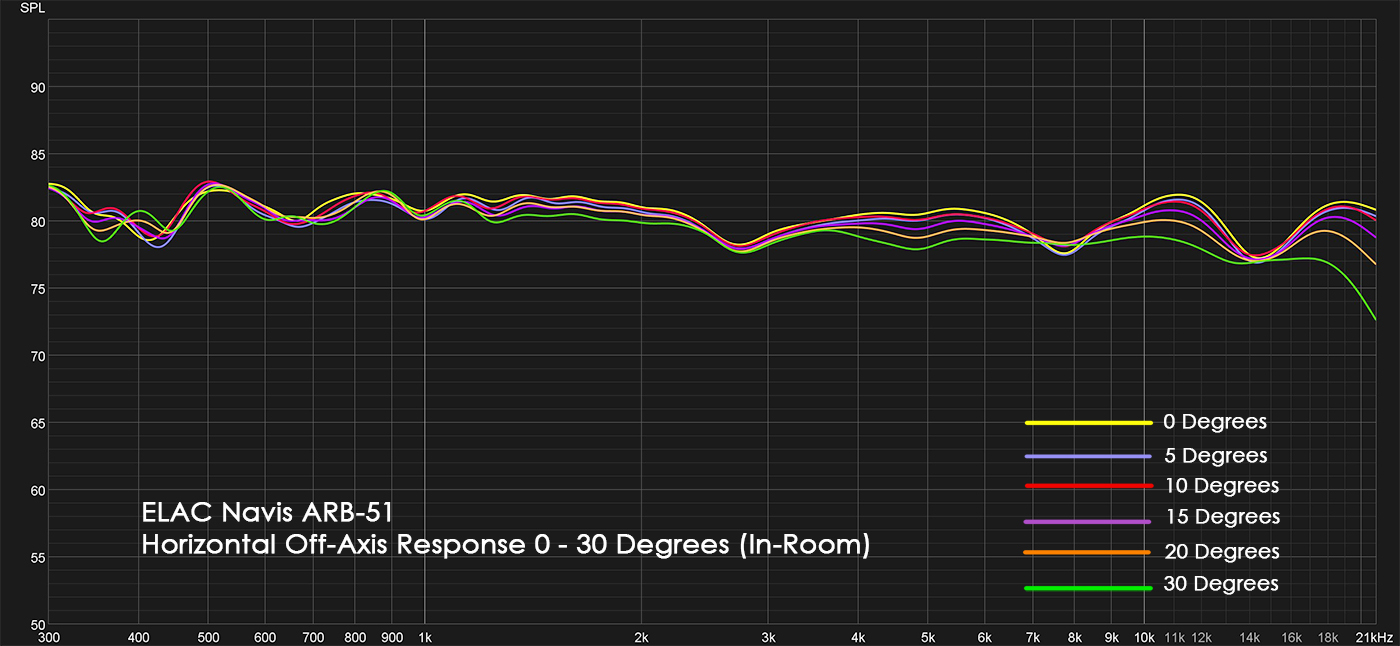
Above are the horizontal radiation curves of the ELAC Navis ARB-51 from 0 to 30 degrees. Note the response gets smoother as we move off-axis to 30 degrees. From the in-room response, enough early reflections are getting to the listener at smaller angles, so the ripples are still present in the in-room curve.
The activity below 400Hz is likely from a room reflection so only look above 400Hz. The speaker has a low 260Hz woofer – midrange crossover. Any activity from the crossover is not going to be seen above 300Hz.
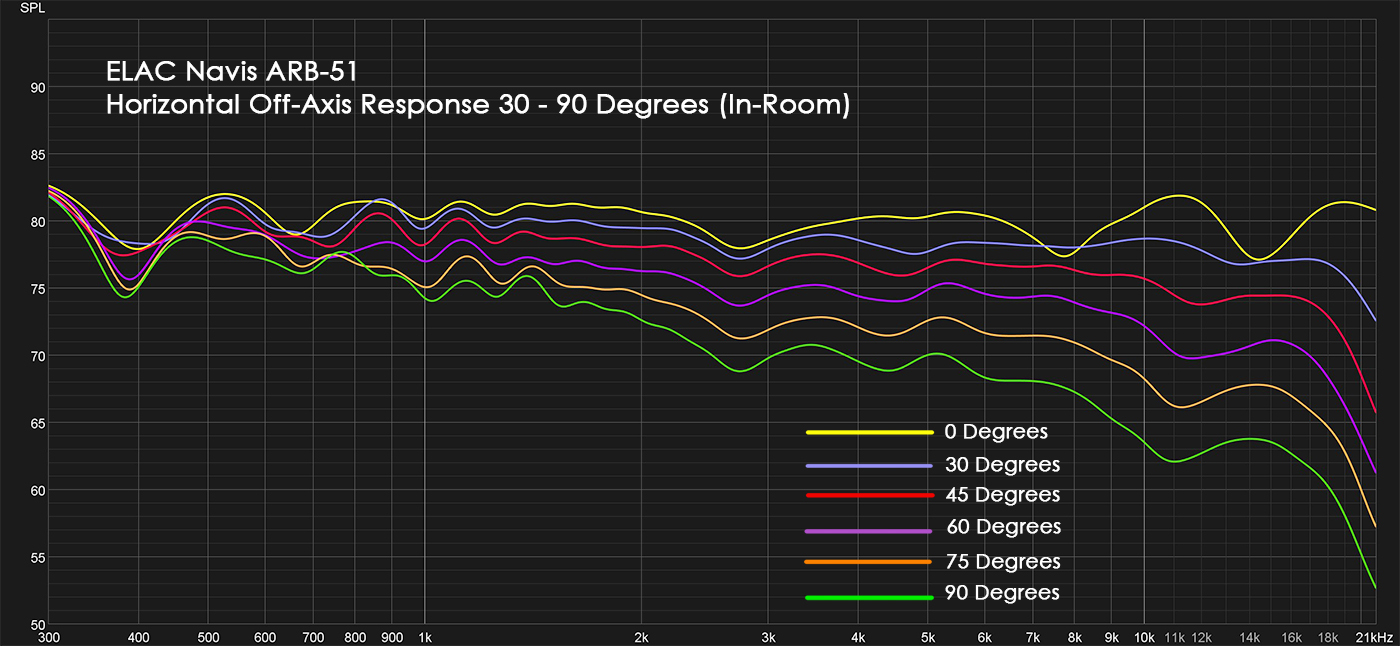
Above are the horizontal radiation curves of from 30 to 90 degrees. We see a small snap back of the response as the midrange transitions to the tweeter at 2.5kHz. The midrange cone is acting as a waveguide and increases the off-axis response of the tweeter to almost match the midrange. This is very important to ensure the on-axis and early reflection response track each other.
On the other hand, interference as a result of the tweeter being mounted inside the midrange is seen at 5kHz and 11kHz. Coax design has been advancing in this decade. In the past much larger and more frequent interference patterns would have been noted.
A coax driver also has an inherent issue with IM distortion identified decades ago by Paul Klipsch and published in the AES journal.
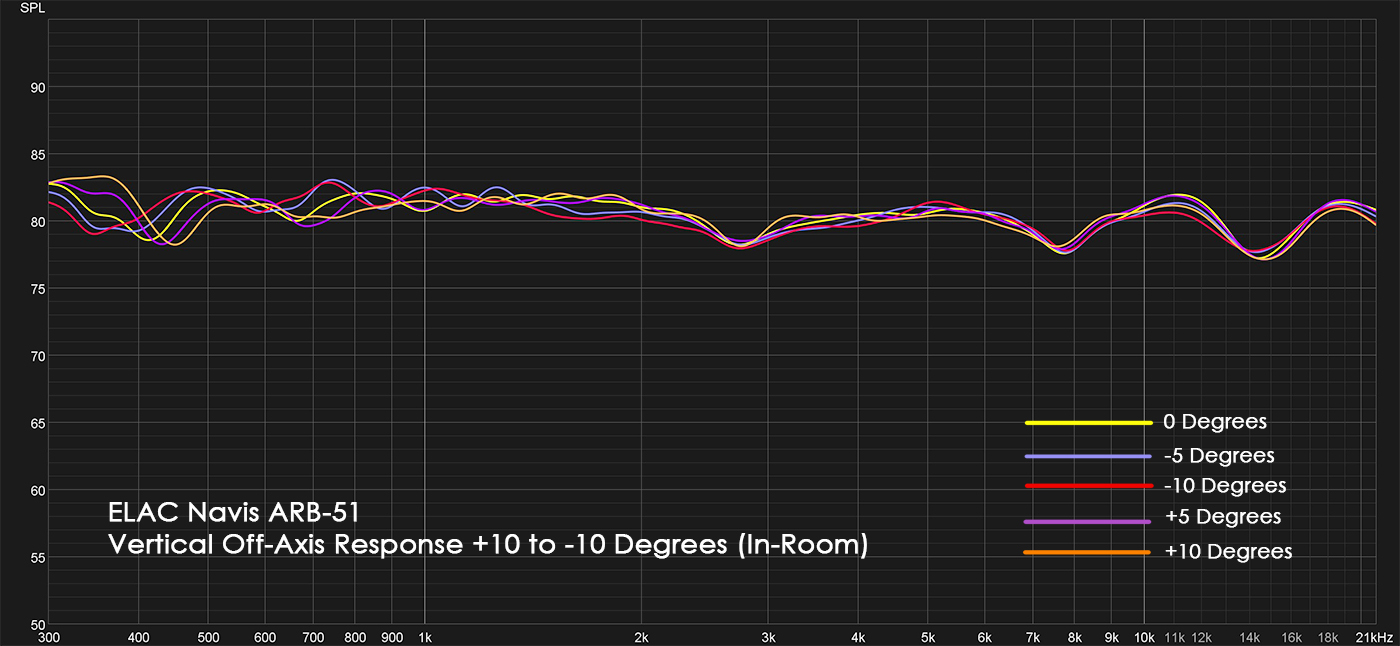
Moving to the vertical radiation pattern for positive and negative angles, we see the plot for +10 to -10 degrees, scaled from 300 Hz on up. You may ask why we did not show the off-axis response at wider angles. It is not the speaker but a room reflection issue. At larger angles, we saw variation below 600Hz that could not be attributed to the speaker. With a 260Hz crossover to the woofer, the vertical response above 300Hz should be the same as the horizontal and indeed it is. We just could not capture it to show you.
In speakers with displaced midranges and tweeters, the vertical response deteriorates rapidly and results in very different looking vertical early reflections. With a coax, the matched, well-controlled vertical response of the ELAC improves the matching of the early reflection and power response curves to the on-axis curves. The directivity indices would show less non-monotonic behavior.
The trade-off is the ripples in the tweeter from midrange cone interference. That is here in the ELAC, and it is not as good one competitive passive product at the same price point even though they have larger cone sizes (5.25 inch), presenting a greater design challenge to reduce the ripples. The larger cone of the competitive speaker also solves the potential THD issue in this speaker at 250Hz.
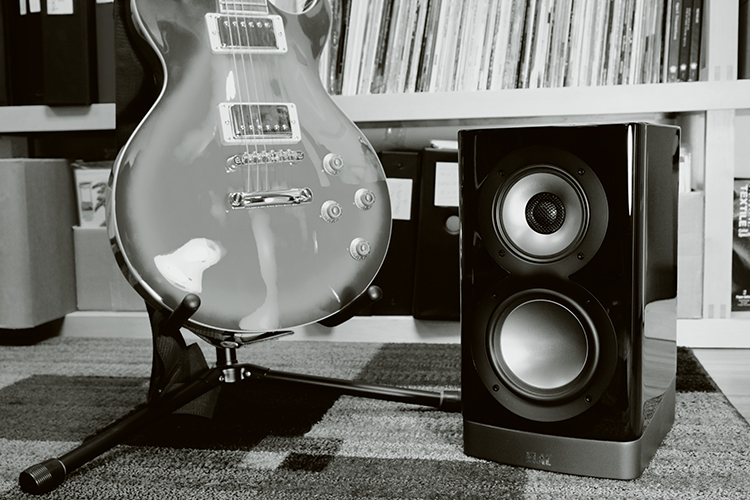
Finally, a high-quality active loudspeaker that works for the audiophile and doesn’t require a second mortgage to own!
- Effective active design.
- Big soundstage with plenty of detail.
- Impressive bass for the size.
- Good enough to show off the strengths of the upstream components.
- Flexible.
- I’d like to see a version of the Navis with slightly larger drivers. Maybe a 5.25-inch midrange and an 8-Inch woofer. That could be really interesting.
The ELAC Navis ARB-51 is an excellent sounding pair of speakers that are designed to gracefully introduce the audiophile to the benefits of active speakers without depriving him, or her, of some of the choices in other components they might want to use. They arrive ideally mated with the correct amount and type of amplification already on board. The crossovers are properly matched and configured for amps and drivers, exploiting the available resources better than any passive arrangement could. Convenient rear panel adjustments allow for a degree of tuning flexibility and integrating a subwoofer (or two) if you so desire. What you are not saddled with is any of the digital bits that can’t be changed or upgraded if they are living inside the speakers. You still get the fun, joy, worry (or whatever) of picking that stuff out for yourself. You can use whichever preamp, DAC, or room correction system you like with the Navis. They remain, as they are, suitable and flexible to adapt to a multitude of user situations. Buy yourself one of these new preamps that have streaming capabilities, like ELAC’s Alchemy DDP-2 or the NAD C658, and hook up these speakers. Boom, you’re done! An HT receiver with streaming resources and a set of pre-out jacks will work just as well. The point being that the Navis is designed to scale with you and your equipment. Due to their active design, they are good enough to reap the benefits of the better-quality equipment that you grow into. Case in point the Benchmark preamp and DAC that I used with them towards the end of the review. Squeaky clean sounding and transparent as hell, the Navis ARB-51 speakers became quite the revealing little totems when fronted with this gear. Most high caliber active loudspeakers these days will cost you a pretty penny. $2300.00 for the pair does not seem an unreasonable price to ask for these little gems. It makes me wonder what the towers must sound like. It also brings to mind the old Burger King jingle; “Have it your way”! Thank you ELAC for holding the onions!
From Andrew Jones, VP of Engineering at ELAC America.
Thanks for the review. Altogether a good, well-reasoned review of what the product does and what my objectives were.
The only commentary I really have is with respect to your interpretation of some of the measurements, and the anomalies seen in the response curves.
Pretty much every anomaly that shows up is not due to resonances, but due to diffraction related artifacts.
It’s astonishing when you look at driver response, and make measurements going from very close in, all the way out to 2m, and see the effects of diffraction start to intrude and mess up the smoothness of the response!
Even the dip at 2.8kHz is due to diffraction imposed on the tweeter, and not the crossover point. The 8kHz dip is due to tweeter/cone interference, and the 14kHz dip is due to the cone/baffle interface.
These are not easy to get rid of and are a consequence of the concentric process. There are some designs that have mostly eliminated some of them, but that process can introduce other problems.
As you show, the most severe dips even out off-axis. The 2.8kHz evens out in the vertical direction. As a result, I always design to balance the overall power response with the axial response rather than optimize for one parameter only.
Through experience, I have found the best compromise. I could easily, with DSP, equalize any response curve I want to look very flat. This never sounds the best solution.
I also never listen to any speaker directly on-axis. This is always the point of maximum symmetry and worst-case frequency response due to diffraction, even with regular non-concentric speakers.
Measures that can be taken to reduce diffraction, such as very heavily radiused cabinet edges (2” radii for example) almost never look good and also considerably add to the cost.
The secret to speaker design, especially low cost or very high value, is applying the best compromise between necessity and cost.
Thanks once again for a great review.
All the best
Andrew



